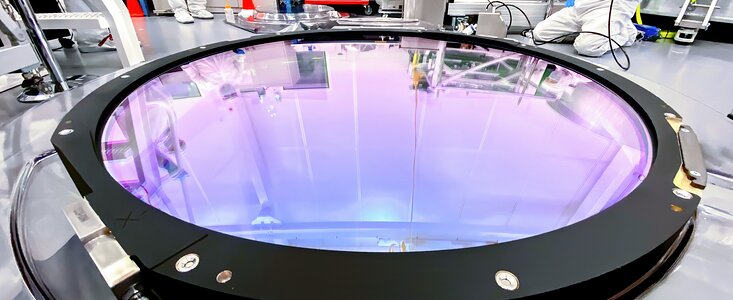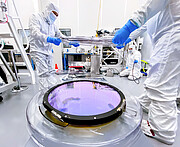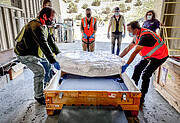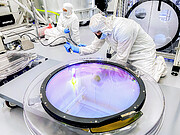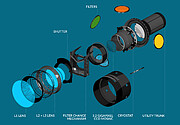First LSST Camera Filter Arrives at SLAC
23 March 2021
The first completed filter for the Rubin Observatory LSST Camera has arrived at SLAC National Accelerator Laboratory! The r-band filter was delivered to SLAC on 12 March 2021, marking an exciting milestone for the LSST Camera team.
The r-band filter is one of six filters that will be used in the LSST Camera, each optimized to collect light within a specific range of the electromagnetic spectrum. Each filter is about 76 cm (30 inches) in diameter and weighs about 41 kg (90 lbs). The filters are labeled u, g, r, i, z, and y; together they cover the electromagnetic spectrum between the ultra-violet (u) and the near-infrared (y). The r-band filter, which covers a spectral band near the center of this range, will be one of the filters used most often during the Legacy Survey of Space and Time (LSST). It will also be particularly useful for testing the camera because standard optical techniques can be used to verify the optical performance of the camera when this filter is in place.
From its raw-material state to its recent delivery, the r-band filter has acquired an enviable travel record. The raw material for the substrate, procured in New York State, was shipped to Aix-en-Provence, France, where it was shaped and polished. Then the substrate was sent to Westford, Massachusetts, where the filter coating was applied. From there, the filter traveled to the Lawrence Livermore National Laboratory (LLNL) in California to be installed in its frame, and finally the finished filter was sent to SLAC, in Menlo Park, CA.
At SLAC, the r-band filter will be stored in a special container until the rest of the filters arrive. This is the same storage container that will be used at Vera C. Rubin Observatory in Chile to safely store filters that are not in use, since the filter carousel can only accommodate five of the six filters at any given time. The other filters will arrive at SLAC over the next couple of months; two are currently being installed in their frames at LLNL, and the other three are still with the coating vendor. Installation of all the filters in the filter exchanger, which is also at SLAC, is expected to take place at the end of 2021. After thorough testing, the camera and all its components, including the filters, will be meticulously packed and shipped to Chile in early 2022.
More information
The National Science Foundation (NSF) and Department of Energy (DOE) will support Rubin Observatory in its operations phase to carry out the Legacy Survey of Space and Time. They will also provide support for scientific research with the data. During operations, NSF funding is managed by the Association of Universities for Research in Astronomy (AURA) under a cooperative agreement with NSF, and DOE funding is managed by SLAC under contract by DOE. Rubin Observatory is operated by NSF’s NOIRLab and SLAC.
NSF’s NOIRLab (National Optical-Infrared Astronomy Research Laboratory), the US center for ground-based optical-infrared astronomy, operates the international Gemini Observatory (a facility of NSF, NRC–Canada, ANID–Chile, MCTIC–Brazil, MINCyT–Argentina, and KASI–Republic of Korea), Kitt Peak National Observatory (KPNO), Cerro Tololo Inter-American Observatory (CTIO), the Community Science and Data Center (CSDC), and Vera C. Rubin Observatory (in cooperation with DOE’s SLAC National Accelerator Laboratory). It is managed by the Association of Universities for Research in Astronomy (AURA) under a cooperative agreement with NSF and is headquartered in Tucson, Arizona. The astronomical community is honored to have the opportunity to conduct astronomical research on Iolkam Du’ag (Kitt Peak) in Arizona, on Maunakea in Hawaiʻi, and on Cerro Tololo and Cerro Pachón in Chile. We recognize and acknowledge the very significant cultural role and reverence that these sites have to the Tohono O'odham Nation, to the Native Hawaiian community, and to the local communities in Chile, respectively.
Links
- Announcement on Vera C. Rubin Observatory website
- More Rubin images
- Image gallery on Vera C. Rubin website
Contacts
Amanda Kocz
Press and Internal Communications Officer
NSF’s NOIRLab
Cell: +1 626 524 5884
Email: amanda.kocz@noirlab.edu

